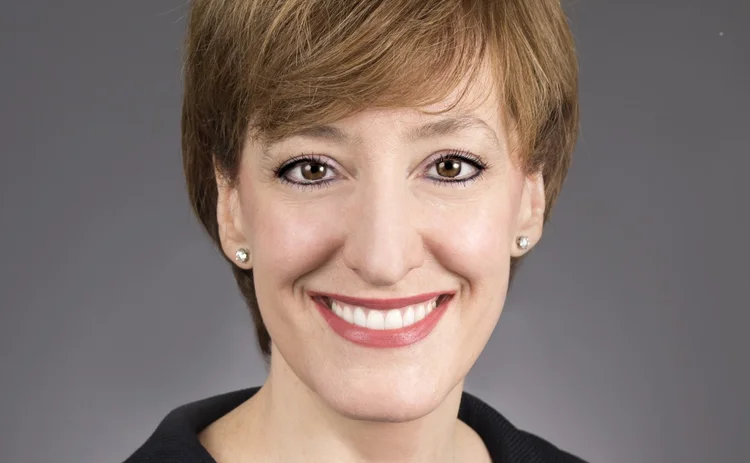Buy-Side Technology Awards 2016: Winners' Circle—Symbiont
Firm's president and chairman discusses the win.

As firms look to begin implementing distributed-ledger technologies, what will be the biggest factors they look for in potential partners? How does Symbiont’s Smart Securities address these requests?
Caitlin Long, president and chairman at Symbiont: Institutional users of distributed-ledger technologies are looking primarily for security, privacy and performance within a permissioned platform. Symbiont’s platform meets each of these requirements. We have market-leading performance, as the speed of our ledger layer—80,000 transactions per second—is multiple orders of magnitude superior to competing platforms. Our security and privacy solutions meet the strict requirements of institutional users, and we proved that in the syndicated loans pilot (which we built along with our joint venture partner, Ipreo). Four major buy-side firms gave our system a test run in that project, within a group of 15 financial institutions, and it passed with flying colors—so much so that others have since joined the project.
How are the buy side’s needs different than the sell side’s when it comes to distributed-ledger technologies?
Long: The needs of the buy and sell sides are really not that different, with one exception—the buy side is more interested in faster settlement than some parts of the sell side. Prime brokerage desks, for example, make money from the delayed settlement inherent to the current market structure that involves multiple intermediaries. We have always said that the biggest beneficiary of distributed-ledger technology is the long-only investment community (pensions, mutual funds, insurance companies and mom and pop investors), and faster settlement enabled by distributed-ledger technology is one of the biggest reasons why we believe this. The long-only community doesn’t benefit from delayed settlement but faces a lot of costs as a result of it—ranging from outdated shareholder lists that cause proxy voting inaccuracies, to the cost of Treasury Market Practices Group (TMPG) fails (stemming from slow collateral settlement), to the risk that a broker-dealer fails with unsettled trades outstanding. Delaware Chancery Court judge Travis Laster calls blockchain the “plunger” that can clean up the financial system’s plumbing, and in a September speech to the Council of Institutional Investors he challenged the buy side to “take back the voting and stockholding infrastructure of the US securities markets” from the sell side. We’d encourage the buy side to read his speech in its entirety.
Symbiont is involved in a pilot project in the syndicated loans space with the buy side. What are the goals of the project and how successful has it been?
Long: Its main goal is to reduce loan settlement times to three days from an average of approximately three weeks currently. Faster settlement will reduce the capital charges faced by agent banks and substantially improve risk-adjusted returns on capital in the syndicated loans business. The faster velocity of capital should improve liquidity in the market generally. For the buy side specifically, there’s an inherent risk issue when a fund offers daily liquidity in an asset class whose settlement cycle is measured in weeks, not days. And, of course, both the buy and sell sides benefit from operational cost reductions. The project has successfully met three of five milestones and is expected to be completed in early December.
Symbiont also took part in a pilot program with Allianz and Nephila Capital around a catastrophe swap transaction. Can you elaborate on what that involved?
Long: This project, like the syndicated loans project, also involved the buy side—as Nephila is one of the largest investors in insurance-linked securities. The deliverable in this pilot was a catastrophe swap involving Allianz and Nephila, but the technology is portable to any type of swap or reinsurance contract. The “smart swap” we created for this project automates payments when the swap was triggered—in this case, the trigger was a storm whose losses (as calculated by an independent calculation agent) exceeded a threshold amount. The project delivered a perfect audit trail and proved that record-keeping costs can be reduced by avoiding the need to reconcile. Allianz is continuing to work toward deploying distributed-ledger technology, as it subsequently announced that it formed a consortium with four other major insurance companies, called B3i, to facilitate multi-party projects in the insurance industry.
Only users who have a paid subscription or are part of a corporate subscription are able to print or copy content.
To access these options, along with all other subscription benefits, please contact info@waterstechnology.com or view our subscription options here: http://subscriptions.waterstechnology.com/subscribe
You are currently unable to print this content. Please contact info@waterstechnology.com to find out more.
You are currently unable to copy this content. Please contact info@waterstechnology.com to find out more.
Copyright Infopro Digital Limited. All rights reserved.
As outlined in our terms and conditions, https://www.infopro-digital.com/terms-and-conditions/subscriptions/ (point 2.4), printing is limited to a single copy.
If you would like to purchase additional rights please email info@waterstechnology.com
Copyright Infopro Digital Limited. All rights reserved.
You may share this content using our article tools. As outlined in our terms and conditions, https://www.infopro-digital.com/terms-and-conditions/subscriptions/ (clause 2.4), an Authorised User may only make one copy of the materials for their own personal use. You must also comply with the restrictions in clause 2.5.
If you would like to purchase additional rights please email info@waterstechnology.com
More on Awards & Rankings
Witad Awards 2025 winner’s interview: Maureen Downs (Connamara Technologies)
Video interview with Connamara Technologies co-founder, and winner of the trailblazer vendor category in the 2025 Witad Awards, Maureen Downs
Buy-Side Technology Awards 2024 winner’s interview: FactSet
Video discussion on FactSet’s trio of wins in the 2024 BST Awards
Witad Awards 2025: Vendor professional of the year (business development)—Ripple Bhullar, Kyndryl
Ripple Bhullar, vice president, head of US capital markets and diversified, at Kyndryl, wins vendor professional of the year (business development) in the 2025 Women in Technology and Data Awards.
Witad Awards 2025: Technology leader of the year (vendor)—Mary Cecola, Broadridge Financial Solutions
Mary Cecola, CTO for asset management at Broadridge Financial Solutions, wins technology leader of the year (vendor) in the 2025 Women in Technology and Data Awards.
Witad Awards 2025: Trailblazer (Lifetime achievement) award (vendor)—Maureen Downs, Connamara Technologies
Maureen Downs, co-founder and chair of Connamara Technologies, wins the Trailblazer (Lifetime achievement) award (vendor) in the 2025 Women in Technology and Data Awards.
Witad Awards 2025: Legal/compliance professional of the year—Devi Shanmugham, Tradeweb
Devi Shanmugham, global head of compliance at Tradeweb, wins legal/compliance professional of the year in the 2025 Women in Technology and Data Awards.
Witad Awards 2025: Technology innovator of the year (end-user)—Ruchi Acharya Saraswat, RBC Capital Markets
Ruchi Acharya Saraswat, managing director, head of strategy and transformation, business and client services technology at RBC Capital Markets, wins technology innovator of the year (end-user) in the 2025 Women in Technology and Data Awards.
Witad Awards 2025: Best company for diversity and inclusion (end-user)—BNP Paribas Portugal
BNP Paribas Portugal wins best company for diversity and inclusion (end-user) in the 2025 Women in Technology and Data Awards.



